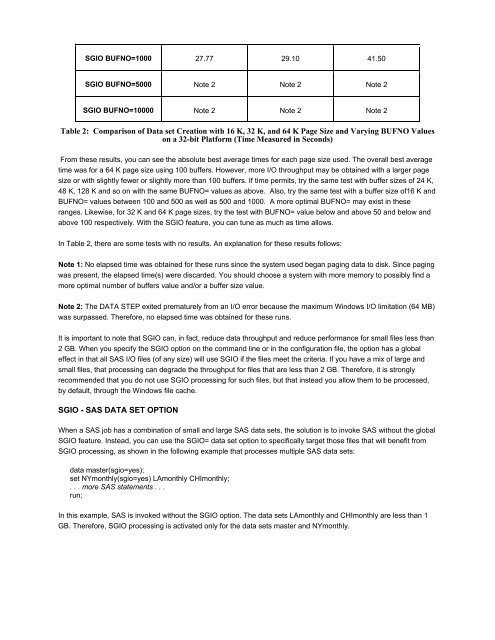Improving SAS® I/O Throughput by Avoiding the Operating System ...
Improving SAS® I/O Throughput by Avoiding the Operating System ...
Improving SAS® I/O Throughput by Avoiding the Operating System ...
You also want an ePaper? Increase the reach of your titles
YUMPU automatically turns print PDFs into web optimized ePapers that Google loves.
SGIO BUFNO=1000 27.77 29.10 41.50<br />
SGIO BUFNO=5000 Note 2 Note 2 Note 2<br />
SGIO BUFNO=10000 Note 2 Note 2 Note 2<br />
Table 2: Comparison of Data set Creation with 16 K, 32 K, and 64 K Page Size and Varying BUFNO Values<br />
on a 32-bit Platform (Time Measured in Seconds)<br />
From <strong>the</strong>se results, you can see <strong>the</strong> absolute best average times for each page size used. The overall best average<br />
time was for a 64 K page size using 100 buffers. However, more I/O throughput may be obtained with a larger page<br />
size or with slightly fewer or slightly more than 100 buffers. If time permits, try <strong>the</strong> same test with buffer sizes of 24 K,<br />
48 K, 128 K and so on with <strong>the</strong> same BUFNO= values as above. Also, try <strong>the</strong> same test with a buffer size of16 K and<br />
BUFNO= values between 100 and 500 as well as 500 and 1000. A more optimal BUFNO= may exist in <strong>the</strong>se<br />
ranges. Likewise, for 32 K and 64 K page sizes, try <strong>the</strong> test with BUFNO= value below and above 50 and below and<br />
above 100 respectively. With <strong>the</strong> SGIO feature, you can tune as much as time allows.<br />
In Table 2, <strong>the</strong>re are some tests with no results. An explanation for <strong>the</strong>se results follows:<br />
Note 1: No elapsed time was obtained for <strong>the</strong>se runs since <strong>the</strong> system used began paging data to disk. Since paging<br />
was present, <strong>the</strong> elapsed time(s) were discarded. You should choose a system with more memory to possibly find a<br />
more optimal number of buffers value and/or a buffer size value.<br />
Note 2: The DATA STEP exited prematurely from an I/O error because <strong>the</strong> maximum Windows I/O limitation (64 MB)<br />
was surpassed. Therefore, no elapsed time was obtained for <strong>the</strong>se runs.<br />
It is important to note that SGIO can, in fact, reduce data throughput and reduce performance for small files less than<br />
2 GB. When you specify <strong>the</strong> SGIO option on <strong>the</strong> command line or in <strong>the</strong> configuration file, <strong>the</strong> option has a global<br />
effect in that all SAS I/O files (of any size) will use SGIO if <strong>the</strong> files meet <strong>the</strong> criteria. If you have a mix of large and<br />
small files, that processing can degrade <strong>the</strong> throughput for files that are less than 2 GB. Therefore, it is strongly<br />
recommended that you do not use SGIO processing for such files, but that instead you allow <strong>the</strong>m to be processed,<br />
<strong>by</strong> default, through <strong>the</strong> Windows file cache.<br />
SGIO - SAS DATA SET OPTION<br />
When a SAS job has a combination of small and large SAS data sets, <strong>the</strong> solution is to invoke SAS without <strong>the</strong> global<br />
SGIO feature. Instead, you can use <strong>the</strong> SGIO= data set option to specifically target those files that will benefit from<br />
SGIO processing, as shown in <strong>the</strong> following example that processes multiple SAS data sets:<br />
data master(sgio=yes);<br />
set NYmonthly(sgio=yes) LAmonthly CHImonthly;<br />
. . . more SAS statements . . .<br />
run;<br />
In this example, SAS is invoked without <strong>the</strong> SGIO option. The data sets LAmonthly and CHImonthly are less than 1<br />
GB. Therefore, SGIO processing is activated only for <strong>the</strong> data sets master and NYmonthly.
















